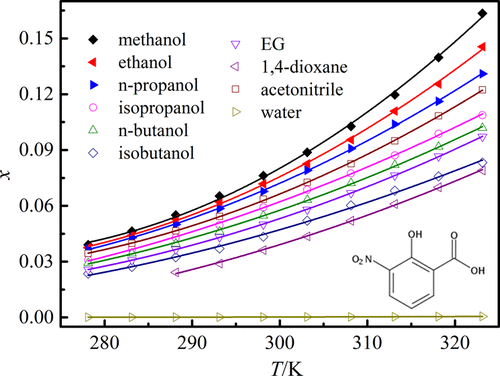当前位置:
X-MOL 学术
›
J. Chem. Eng. Data
›
论文详情
Our official English website, www.x-mol.net, welcomes your feedback! (Note: you will need to create a separate account there.)
Equilibrium Solubility and Solvent Effect Study of 3-Nitrosalicylic Acid in Different Monosolvents Covering Temperatures from 278.15 to 323.15 K
Journal of Chemical & Engineering Data ( IF 2.6 ) Pub Date : 2021-06-16 , DOI: 10.1021/acs.jced.1c00259 Gui Han 1 , Xi Zhao 1 , Ali Farajtabar 2
Journal of Chemical & Engineering Data ( IF 2.6 ) Pub Date : 2021-06-16 , DOI: 10.1021/acs.jced.1c00259 Gui Han 1 , Xi Zhao 1 , Ali Farajtabar 2
Affiliation

|
The measurement of equilibrium solubility for 3-nitrosalicylic acid in 13 monosolvents such as methanol, N,N-dimethylformamide (DMF), isobutanol, ethanol, ethylene glycol (EG), N-methyl-2-pyrrolidinone (NMP), n-propanol, ethyl acetate, isopropanol, water, n-butanol, acetonitrile, and 1,4-dioxane was made by the saturation shake-flask technique covering temperatures from 278.15 to 323.15 K under p = 101.2 kPa. As the studied temperature increased, the mole fraction solubility of 3-nitrosalicylic acid increased and had a decreasing tendency in the following order: NMP > DMF > ethyl acetate > methanol > ethanol > n-propanol > acetonitrile > isopropanol > n-butanol > EG > isobutanol > 1,4-dioxane > water. The solvent effects, such as solvent–solute and solvent–solvent molecular interactions, were further examined by the linear solvation energy relationships. Then, the equilibrium solubility magnitudes were correlated with thermodynamic models and semiempirical equations, namely, Wilson, Apelblat, λh, and NRTL. The calculated maximum value of root-mean-square deviation was 182.0 × 10–4, and the maximum value of relative average deviation was 7.24 × 10–2. In general, the obtained relative average deviation values with the Apelblat equation were smaller than those with the other equation/models for a fixed monosolvent. Finally, the mixing solution properties, activity coefficient, and partial molar excess enthalpy at infinite dilution were determined with the help of the Wilson equation.
中文翻译:

3-硝基水杨酸在278.15~323.15 K不同单溶剂中的平衡溶解度和溶剂效应研究
平衡溶解度的3-硝基水杨酸在13个monosolvents如甲醇,测量Ñ,Ñ二甲基甲酰胺(DMF),异丁醇,乙醇,乙二醇(EG),ñ -甲基-2-吡咯烷酮(NMP),Ñ丙醇、乙酸乙酯、异丙醇、水、正丁醇、乙腈和 1,4-二恶烷是通过饱和摇瓶技术制备的,温度范围为 278.15 至 323.15 K,p = 101.2 kPa。随着研究温度的升高,3-硝基水杨酸的摩尔分数溶解度增加并呈下降趋势:NMP>DMF>乙酸乙酯>甲醇>乙醇>正丙醇>乙腈>异丙醇>正丁醇 > EG > 异丁醇 > 1,4-二恶烷 > 水。通过线性溶剂化能关系进一步检查溶剂效应,例如溶剂-溶质和溶剂-溶剂分子相互作用。然后,平衡溶解度大小与热力学模型和半经验方程相关,即 Wilson、Apelblat、λ h和 NRTL。计算出的均方根偏差最大值为182.0 × 10 –4,相对平均偏差最大值为7.24 × 10 –2. 一般来说,对于固定的单溶剂,使用 Apelblat 方程获得的相对平均偏差值小于使用其他方程/模型获得的相对平均偏差值。最后,在威尔逊方程的帮助下,确定了无限稀释时的混合溶液性质、活度系数和部分摩尔过量焓。
更新日期:2021-07-08
中文翻译:

3-硝基水杨酸在278.15~323.15 K不同单溶剂中的平衡溶解度和溶剂效应研究
平衡溶解度的3-硝基水杨酸在13个monosolvents如甲醇,测量Ñ,Ñ二甲基甲酰胺(DMF),异丁醇,乙醇,乙二醇(EG),ñ -甲基-2-吡咯烷酮(NMP),Ñ丙醇、乙酸乙酯、异丙醇、水、正丁醇、乙腈和 1,4-二恶烷是通过饱和摇瓶技术制备的,温度范围为 278.15 至 323.15 K,p = 101.2 kPa。随着研究温度的升高,3-硝基水杨酸的摩尔分数溶解度增加并呈下降趋势:NMP>DMF>乙酸乙酯>甲醇>乙醇>正丙醇>乙腈>异丙醇>正丁醇 > EG > 异丁醇 > 1,4-二恶烷 > 水。通过线性溶剂化能关系进一步检查溶剂效应,例如溶剂-溶质和溶剂-溶剂分子相互作用。然后,平衡溶解度大小与热力学模型和半经验方程相关,即 Wilson、Apelblat、λ h和 NRTL。计算出的均方根偏差最大值为182.0 × 10 –4,相对平均偏差最大值为7.24 × 10 –2. 一般来说,对于固定的单溶剂,使用 Apelblat 方程获得的相对平均偏差值小于使用其他方程/模型获得的相对平均偏差值。最后,在威尔逊方程的帮助下,确定了无限稀释时的混合溶液性质、活度系数和部分摩尔过量焓。



























 京公网安备 11010802027423号
京公网安备 11010802027423号